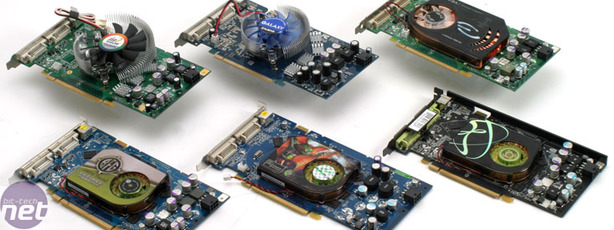GeForce 7900 GS Group Test
September 21, 2006 | 11:03

Gameplay Evaluations - How We Tested:
There are no timedemos used in our evaluations - we're focusing on the real-world gameplay experience. Ultimately, this is what should determine your next video card purchase.Because the benchmarks are done manually, there are slight differences between runs. However, we have run each benchmarking scenario through at least three times to get consistent frame rates across the board. Over the course of the evaluation, you will not go far wrong by following the logic that the higher the resolution and in game details, the faster the graphics solution in that particular title.

NVIDIA GeForce 7-series System Setup
- BFG Tech GeForce 7900 GS OC 256MB - operating at its default clock speeds of 540/1360MHz;
- EVGA e-GeForce 7900 GS KO 256MB - operating at its default clock speeds of 500/1380MHz;
- Galaxy GeForce 7900 GS 256MB - operating at its default clock speeds of 540/1500MHz;
- Inno3D GeForce 7900 GS 256MB - operating at its default clock speeds of 450/1320MHz;
- Point Of View GeForce 7900 GS 256MB - operating at its default clock speeds of 450/1320MHz;
- XFX GeForce 7900 GS 480M Extreme 256MB - operating at its default clock speeds of 480/1400MHz.
ATI Radeon X1000-series System Setup
- ATI Radeon X1900GT 256MB - operating at its default clock speeds of 575/1200MHz;
- ATI Radeon X1800GTO 256MB - operating at its default clock speeds of 500/990MHz.
________________________________________________________________________________
We use the following abbreviations on our best-playable settings tables:
- QA AA - Quality Adaptive anti-aliasing (ATI Radeon X1000 series);
- PA AA - Performance Adaptive anti-aliasing (ATI Radeon X1000 series);
- HQ AF - High Quality Anisotropic Filtering (ATI Radeon X1000 series);
- TS AA - Transparency SuperSampled anti-aliasing (NVIDIA GeForce 7 series);
- TM AA - Transparency MultiSampled anti-aliasing (NVIDIA GeForce 7 series);
- HQ Driver - High Quality Driver Settings to remove noticeable texture shimmering in certain titles (NVIDIA).

MSI MPG Velox 100R Chassis Review
October 14 2021 | 15:04







Want to comment? Please log in.